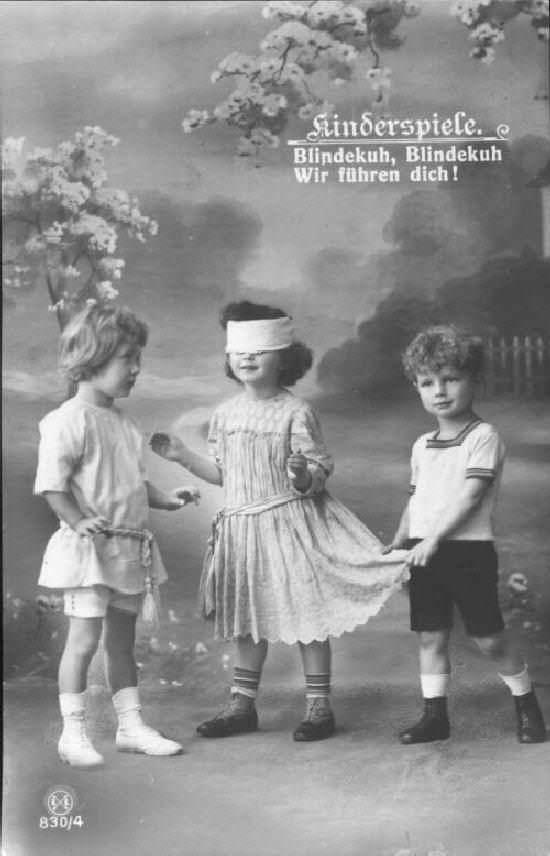
Blindman's Bluff

Figure 1.--This German pre-World War I postcard shows children playing Blindmans Bluff. A girl wears a dress. A boy wears a sailor blose and shorts. Note the child on the left wearing a tunic suit. We believe this child is a boy. Image courtesy of Albumn 1900.
|
One very popular game was "Blindman's bluff". The game was very simple. One player was blindfolded spun around a number of times, often three times. The blindfolded player tries to tag one of the other players, who are allowed to crouch low or sneak up behind the "blindman" and yell "Boo"! Others stand still and try keep as quiet as possible. Eventually one of the other players gets careless and is tagged. Than that player is blindfolded for the next game. We are not sure whem the game was first played. It became seen as a children's game and was very popular for children's parties in the 19th century and early 20th century. The origins, however, appear to have been much earlier, certainly the 18th century if not earlier. And it was not at first played by children. The game can be played both indoors and outdoors, but is well suited for indoor play. The confines of a room give the "blindman" a better chance than more open outdoor locations. We know that the game was played in many different locations, including America, England France, Germany and other countries.
The Game
One very popular game was "Blindman's bluff". The game was very simple. One advantage was that the only equiopment needed was a blindfold. One player was blindfolded spun around a number of times, often three times. The blindfolded player than calls out "Blindman's Bluff," and tries to tag one of the other players, who are allowed to crouch low or sneak up behind the "blindman" and yell "Boo"! Others stand still and try keep as quiet as possible. If I remember ciorrecly, when we payed the game in the 1940s, the others players were not allowed to move when the "blindman" started searching. If the game was played in doors and the room was small, than the palyers were allowed to move. Eventually one of the other players gets careless and is tagged. Than that player is blindfolded for the next game.
Chronology
We are not sure whem the game was first played. It became seen as a children's game and was very popular for children's parties in the 19th century and early 20th century. The origins, however, appear to have been much earlier, certainly the 18th century and probably much earlier.
Players
And it was not at first played by children. The earliest players were adults in European courts. It was a popular game in which men and women could play.
Location
The game can be played both indoors and outdoors, but is well suited for indoor play. The confines of a room give the "blindman" a better chance than more open outdoor locations.
Countries
We know that the game was played in many different locations, including America, England France, Germany and many other countriesas well. In German the Blindman becomes a Blind cow. The German children here are saying, "Kinderspiefe. Blindekuhm Blindekuh. Wie führen dich!" ("Children's game. Blind cow ; blind cow ; we lead you "!) This is what the children chant. This game is also called Blindekuh in Austria. In France it was known as Colin Maillard. All children know this game.
Parlor Games
"Parlor games" were a very popular activity for children in the Victoraian and Edwardian era. The term "parlor games" derived from the fact that they were played by guests in the best room of the house--the parlor. In some homes, the children were not allowed in the parlor except on special days when guests were being entertained. Some of the different games included, "Charades", "Blindman's Bluff", and "Pin the Tail on the Donkey". These games continue to be popular, especially as children's games for birthday parties.
Christopher Wagner

Navigate the Boys' Historical Clothing Web
[Return to the Main outdoor play page]
[Return to the Main Activities page]
[Introduction]
[Activities]
[Bibliographies]
[Biographies]
[Chronology]
[Clothing styles]
[Countries]
[Literary]
[Contributions]
[FAQs]
[Glossaries]
[Satellite sites]
[Tools]
[Boys' Clothing Home]
Navigate the Boys' Historical Clothing Web Site:
[Sailor suits]
[Sailor hats]
[Buster Brown suits]
[Eton suits]
[Rompers]
[Tunics]
[Smocks]
[Pinafores]
Created: January 22, 2003
Last updated: January 22, 2003



